Why do Cats Have Vertical Pupils?
Why do cats have vertical pupils? Do clouds defy gravity? What is the brain basis of road rage? The Naked Scientists team tackle these and many more science questions, with help from an all-star guest panel.
In this episode
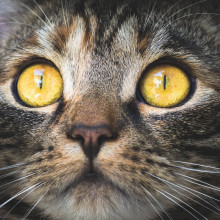
Why are cat's eyes split vertically?
We put Peter's question to zoologist Max Gray...
Max - So this is all to do with the fact that cats are very active at night and they need good night vision as well as having day vision - so they're not fully nocturnal and not fully diurnal. They're active at both times of day. But they've got very sensitive eyes so they can see at night but, as a result, during they day they can get very over-sensitive so they need to be able to control the amount of light that gets into their eyes really, really precisely - much more precisely than we do. And so, by having a vertical slit as a pupil they can narrow that down to a vertical slit and that controls the light reasonably well but they may need more control than that. By having a vertical slit they can then use their eyelids to close that slit further down to a point. So they have two ways of controlling the amount of light getting into their eyes.
Chris - Ingenious. What about animals like cows and horses - do they not have the slit? Certainly rabbits have slit running front to back, not up and down, don't they?
Max - Often it's not perfectly front to back. It's kind of at an angle and their eyes will move around as they move their heads because they're prey animals.
Chris - They're more interested in what's happening on the horizon?
Max - Yes. And when they're down eating it helps them see around them when they're vulnerable.
Chris - And I suppose if you're a predating animal like a cat, then you're going to be fixating on something and pouncing so you need to have very good depth perception and having a very small pupil is going to give you that, isn't it?
Max - Yes. That's mostly why you have eyes on predators at the front like ours and looking forwards because that's how you hunt. Whereas animals like rabbits and sheep will have eyes on the side of their heads so they can have a better field of vision for things that might pounce on them.
Chris - And we have a round one because that's the best compromise between distance, day, night?
Max - Yes. It's also easiest as well. Interestingly, if you look at cat species that are active during the day, lions are a good example. They don't have slit pupils, they have round, circular and you can go away and google this. If you google lions eyes, you look and they have round pupils like humans.
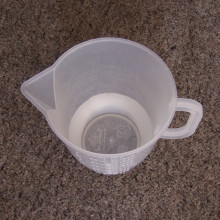
Can you tell the difference between hot water and cold water by listening?
We put Sam's question to Caroline Steel...
Chris - Now just a bit of background because this does sound rather odd like we've all gone mad. But, actually the idea here is that you can tell apart hot and cold water just by the sound when you pour them. Now I'll ask Caroline about the science behind this in a minute, but let's give you at home a go and also everyone here in the studio an opportunity to try this.
So what I have here is I have got two empty glasses. So here's one, here's the other. I've also got two filled glasses and one of them has cold water and the other has hot water. And I'm going to pour one of the glasses at a time into one of the empty glasses and I want you to listen to the sound and we'll see if we can pick up a difference.
I'm just going to move the microphone because, for obvious reasons, I don't want to demolish the studio. Here we go, so this is sample number one. Are we ready, here we go?
[Pouring]
Okay - keep that in mind.
Okay - here is sample number two.
[Pouring]
Right. did we notice. Judith you're a physicist aren't you - did you notice any difference?
Judith - I have to say I don't think I did. I'm not sure I was supposed to but I don't think I did.
Chris - Caroline?
Caroline - I think the first one made a slightly higher pitch noise.
Chris - So, therefore, would you think that was the hot one or the cold one?
Caroline - I think that was the hot one would be my guess.
Chris - Would you concur with that Heidi - what do you think?
Heidi - I could hear the pitch was slightly higher on the first one.
Chris - You are right, the first one was the hot one but now tell us why that should be the case?
Caroline - This is because hot water is slightly less viscous than cold water, so it's a bit more runny. And that's because molecules of water have boiled and they're hotter than the cold water, move around faster, so they form slightly smaller droplets. So that when you pour hot water, these slightly smaller droplets, as they splash against the container or against the water that's already in the container, they make a slightly higher pitch noise. So if you were to say pour custard, you'd expect it to sound a bit lower and it makes bigger droplets which make kind of a more low sound. But, obviously, the difference between hot and cold water is fairly small so I'm really surprised that we managed to hear that one, especially as there are so many factors.
Chris - Max?
Max - What about the difference between hot and cold custard?
Caroline - Well I imagine hot custard is - well we know that don't we. Hot custard is more runny than cold custard so it would make a slightly higher pitched noise.
Why does the kettle get louder as the water heats up but then quieter as it reaches boiling point?
We put Allan's question to physics expert Caroline Steel... Caroline - So, in a kettle, you have a heating element at the bottom and that heats up quickly to actually above one hundred degrees. So the first thing to heat up in a kettle is the water around the heating element. This hot water around the heating element forms tiny little bubbles which then rise up through the kettle, but as these bubbles rise, they rise into an area of colder water. So the bubbles cool down and condense and kind of implode, and the bubbles sort of slaps against itself making a really loud noise.
But as the kettle heats up throughout so all the water inside the kettle is one temperature. As these bubbles form and rise through the water they don't reach an area of colder water, so they actually make it all the way to the surface and then they pop on the surface. But this popping sound on the surface is a lot more gentle and quiet than the sound of the bubbles kind of imploding on themselves within the kettle.
So, if you watch your kettle boil, as it's making a loud sound and coming up to boil you'll see lots of tiny little bubbles in the main body of the water, but you won't see them reach the surface. And then once the kettle has reached boiling point and these bubbles make it to the surface, you'll see them expand and pop but that popping noise is actually quieter than the imploding bubbles in the main body of the water.
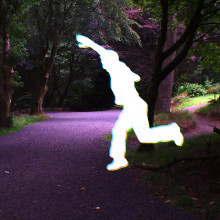
Why are we so creative in our dreams?
We put Helen's question to neuroscientists Heidi Solberg Ã~kland... Heidi - Sleeping and dreaming is not something we understand very well, but we do know a little bit about what's going on in the brain when we're asleep and that might give us a hint as to why we might be a bit more creative in our dreams. So there are different stages of sleep and we dream in all these different stages, but the dreaming she's thinking about is probably the one that happens in REM sleep. So the Rapid Eye Movement sleep, that happens at the end of each cycle so we go through stage 1,2,3,4 into deeper and deeper sleep. During this stage, we know that the hippocampus, the bit of the brain associated with memories, sort of replays the memories we've been making throughout the day, basically just reactivates different parts of the cortex that were involved when we were experiencing something during the day. Lets say we went blackberry picking from this bush we found, so then it's kind of playing that back, so we remember where this really nice bush of blackberries was and so we can find this bush again. But in the REM sleep what happens is the hippocampus goes out of the picture.And then we try to integrate this memory to the other memories we already have. So then, you get different parts of the brain going off. If you wake up during this time, then probably you'll be remembering these strange connections between things that don't really seem to be related, but then your brain may try and integrate that and make a story out of it, which is why dreams may be a bit weird.
Chris - And, the question she's asking, can we be this creative in waking life?
Heidi - Maybe we can! So one thing we also know about REM sleep is that the frontal part of your brain which is more sensible, you choose to do something not something else, so this is kind of your controller in a way, we know this shuts down in REM sleep which allows you to freely associate concepts that aren't usually connected. If you could do that when you're awake, then you could perhaps become more creative.

If aliens could see us what would they see?
We put Omkar's question to Judith Croston... Judith - Well the answer to that is yes. So the questioner is right. If we think about aliens that were say living in the Andromeda galaxy. So the Andromeda galaxy is our nearest galaxy and it is a few million light years away. And so what that means is that any signal that those aliens could measure, it would have to travel at the speed of light to get there. So it would have taken some number of millions of years to get there so what they would be seeing would be prehistoric creatures wandering around on the Earth.
Chris - Doesn't that presuppose that the light hasn't spread out so far that they wouldn't be able to see a dinosaur?
Judith - There are a couple of problems with that. One of them is that, obviously, the sorts of telescopes we have are nothing like good enough to be able to see the prehistoric creatures on planets in the Andromeda galaxy - so that's one problem.
And so when we think about trying to hunt for aliens, we try to think about the sorts of radio signals, we think about technological society. So the earth has been only sending out signals that are likely to be detectable for sort of a hundred years so that's one thing and that's if we think about aliens in a different galaxy.
But I think perhaps what the questioner has missed, or at least isn't in the question, is whether the aliens would have to millions of light years away. Because, in fact, we know of plenty of planets that are a lot closer than that. There are actually, I think, about seventy five known planets within fifty light years. So if there were aliens on one of those planets, then maybe they would be listening in to signals we were sending out, fifty light years away they might be listening to the Beatles on the BBC or something.
Chris - They've got reasonable taste then?
Judith - We don't really know. This light travel time thing is a really important thing to take into account if you're trying to figure out what we can see from alien civilizations and what they might be watching.
Chris - So in summary: the light is spreading out, it's spreading out at the speed of light and, in theory, they could pick up that light, they could interpret what that light came from and the would, effectively, be seeing prehistoric Earth, if they were that far away. But they may be much closer and they may even be watching Neighbours?
Judith - Yes, absolutely.
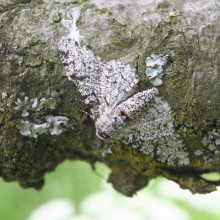
Why do moths come out at night?
We put this question to zoologist Max Gray...
Max - A lot of moths do come out at nighttime but, in fact, not all moths do. There are plenty of moths that are active during the day. So, if you've ever had clothes moths in your wardrobes or eating through your jumpers, they're often active during the day. You'll see them flying around the house and they'll get into your carpets and eat.
Chris - So they're not exclusively active at night?
Max - No they're not, no. And, by and large, a lot of moths are nocturnal and a lot of butterflies are diurnal (active during the day), but you get overlap. There are night butterflies and there are day moths.
Chris - And just in case Mark is picky about the answer and he's saying why are they coming out in the day and night - how do they know it's day and night and what makes them do that behaviour?
Max - It's dark at night is essentially the answer.
Chris - But biologically how do they know it's day and night and to do the behaviour they do - why do they decide I'm going to go out at night and not during the day?
Max - There'll be some mechanism in the brain that gets activated when their eyes are receiving less light and there'll be less active when there's lots of light.
Chris - But why do they fly around a candle and singe their wings - do we know?
Max - Yes. That's to do with how insects navigate at night. So if you imagine starlight and moonlight, because it's coming from a source that's very far away to all intents and purposes the rays of light can be considered parallel, so all light is coming from the same direction. And so a moth wanting to fly in a certain direction will just fly at a set angle, it will decide a direction and set I'm going to fly that way and keep the light coming from the left, or right, or wherever they chose to.
But if you've got a point source of light like a candle or a light bulb hanging from the roof, you can imagine using the same means of navigation, you keep the light bulb to your left. You just slowly spiral in and eventually hit the light. It's not just moths - anybody who's sat on a porch with a candle or a lantern, pretty much all night insects will do that.

How do I feel pain at the point of internal inflammation?
Chris Smith answered Martin's question... Chris - Well the answer is that the way your body develops when you're an embryo, it starts off as a flat sheet of cells and then another flat sheet of cells forms underneath that, and then the whole thing rolls up rather like a tube. So you get a tube inside a tube. If you imagine two plastic plates laying on top of each other and then the edges curving round to meet in the front, the inner tube is your gut tube, and the outer tube is you skin. And along that length the body divides itself up into segments - a bit like a millipede - and those segments are running different genetic instructions and they also have different spinal nerves coming out of the central nervous system that's developing that supply them.
So your body has a pattern and the inputs from those nerves therefore signal where on the body surface and, to a lesser extent, where on the body insides a signal is coming from, so the body can localise pain reasonably well. It's much better at doing it on the outside surface of the body a) because there are more nerves there, and b) because it's more helpful to you to be able, for instance, put your hand in your pocket, feel around and found a two pence coin than being able to do that level of precision with your innards.
But it is useful to know when things are upset inside because, obviously, if you're uncomfortable or if you have stomach ache or something like that, knowing where the pain is it can give you help as to how to make it better. So you do have the ability to do that but you don't do it with the same level of precision.
And a good example of this is when people classically have a heart attack, or angina chest pain because of cardiac pain, they don't just feel the pain where the heart is, they may feel the pain in their neck, they may complain of pain down their left arm. Or, if they're one of the rare individuals in the population who have their heart on the opposite side of the body, they may actually complain of pain going down their right hand side.
Caroline - So I understand that we need to feel where pain is coming from inside us and that helps but why can't we feel any pressure at all because when we digest food we don't feel that at all?
Chris - We do a bit when your tummy rumbles, and you get nervous and you have butterflies in your stomach. That sinking feeling, a bit like before you come on this programme, is because your 'fight or flight' response, your sympathetic nervous system, kicks in and it suppresses the parasympathetic nervous system which is part of your nervous system which makes you rest and digest and it strongly deactivates your intestines. And that shuts down your stomach and shuts down your guts and all the muscles relax, and that sinking feeling is everything going 'urrgh' as it turns off in order to prepare you to run off. So you do have a degree of sensation but your brain is also very good at subtracting from the signals being presented to your consciousness everything which you have got used to. Which is why you put your cloths on this morning and are probably aware of pulling your jumper over your head but then pretty quickly you stop noticing "I'm wearing a jumper." But if your bring it to mind, suddenly you'll start noticing it again. And you think 'ahh' because your brain is mentally subtracting in order to prevent information overload.
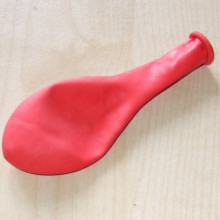
If you pop a balloon in space, would the vaccuum cause the gas to expand at an ever increasing rate?
We put Staffan's question to Caroline Steel...
Caroline - So firstly, unfortunately, you couldn't pop a balloon in space because as soon as you got the balloon into space it would split. And that's because, as the questioner said, there's more gas inside the balloon and there's less gas outside the balloon in the vacuum of space. So the balloon would expand as the gas inside it would want to move towards the area of no gas. So if you could video it and play it in slow mo you could see the balloon expand and then probably split down one side.
Unfortunately, you wouldn't even be able to hear this sort of 'pop' as there's no molecules to take the sound to your ears so you wouldn't hear it. And then once the balloon has split the molecules from inside the balloon would travel off into the vastness of space never to be seen again.
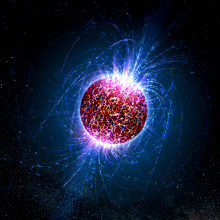
Is it possible there is a new element hidden inside a Neutron star?
We put Paul's question to Judith Croston...
Judith - Okay, so to the answer to this is no, but it's quite interesting why. So I should start perhaps by briefly explaining what a neutron star is. So, just as a reminder, a neutron star is one of these really strange stars. You take an ordinary star, so you could say take all of the matter in our solar system and squash it down to an incredibly high density so you could fit our solar system inside the M25, basically. Neutron stars are about ten kilometers in size but they all the matter inside them that an entire solar system could have.
Chris - Like one teaspoon full weighs millions of tons?
Judith - Yes. A teaspoon full could weigh the same as Mount Everest or something so they're very strange. The physics of them is really weird. They have very strong gravity but the important thing is the density and the pressure in the centre of neutron star is so incredibly high we just don't understand how physics work in those conditions, we can't do experiments in the lab.
So there are quite a lot of exotic theories about what could happen in the centre of a neutron star, but one thing that couldn't happen is the creation of a new chemical element similar to the sorts of things we have on the periodic table because chemical elements have protons and neutrons bound together and then they have orbits of electrons spinning around. And what happens in a neutron star is that as, when the star forms the protons and the electrons that were there, and the nuclei from the star, they combine together so the electrons and the protons combine together to make neutrons. So there's no space to have these orbitals of electrons spinning around so you couldn't make a new element like that.
On the other hand, there are theories about all sorts of weird things that could go on in the centre of neutron stars because the neutrons themselves might break down into quarks, which are the little particles that you get inside neutrons and protons. And then those quarks can do quite strange things and then combine together in various ways. So people are quite interested in trying to figure out the physics of neutron stars because it might tell us something interesting about those sorts of exotic states.

Why do people get rude in cars?
We put Alicia's question to neuroscientists Heidi Solberg Ã~kland...
Heidi - So there are kind of maybe three main reasons why people get angry more often when they're driving. One is that if you imagine driving somewhere, your one your way to some appointment and you have a goal - you're going somewhere. So anything that's going to come in your way is going to be obstructing you to getting to that goal where you want to be. So just that is something that will start to annoy people.
Chris - People are really, really quite nasty in certain circumstances but then in real life - I use that phrase to mean when they're not behind the wheel - they're really nice people, so why do they go sort of Jekyll and Hyde like that?
Heidi - There are two reasons maybe. One is that comparing driving a car to walking on a pavement for instance, and there's lots of people. When you're just walking around and someone is cutting off, you don't really start shouting at those people because then that means you actually have to face them.
Chris - Especially if they're bigger than you!
Heidi - Yes. Whereas when you're in a car, you don't really see them, so that's one thing. Or you might see them but they might just be passing by and you can shout at them but you don't get any conversation.
Chris - You're shouting. Do you shout at people behind the wheel?
Heidi - I don't tend to do so but I have a good friend who tends to do it.
Chris - Are you a shouty person Judith?
Judith - Not as much as my husband is.
Heidi - So you don't really get any chance to get a reaction from anyone so you can just go on and be really angry at them.
Chris - I feel like it's a self-fulfilling prophecy because there's nothing there to abate your excitement. You just keep getting more and more riled about it because they can't even explain that they weren't really trying to wind you up, it just sort of accidently happened.
Heidi - Exactly. And the other thing is that you sort of get a bit more anonymous, I guess. It's a bit like commenting on the web or.
Chris - Like social media trawling?
Heidi - Yes. So it's kind of, maybe, something along the same lines, yes.
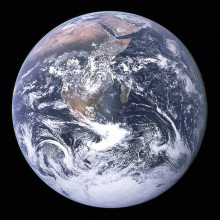
What tiny changes could we all make to reduce enviromental impact?
We put this to zoologist Max Gray... Max - So there's a whole bunch of things you could do: making sure you've turned your lights off; don't leave the fridge door open too long when you're looking in the fridge; spend less time in the shower. There's lots of things that will make a tiny difference but the small things that won't necessarily change your life that much but that could make the biggest difference is what you choose to eat. The amount of meat you eat is probably on an individual basis, per person, the biggest single contribution to how much environmental impact you, as a person, have. I'm not saying everybody needs to go vegetarian or, indeed, needs to give up meat but just eating less meat. Loads of people eat meat for two meals a day, particularly will have meat during lunch and during dinner.
Chris - Why is meat so bad Max?
Max - It's because of the amount of energy that is required to produce meat compared to producing vegetables, for example. Energy initially comes from the Sun and gets absorbed by plants through photosynthesis. They create proteins and sugars and that's where you get the food from. The efficiency is better going from sunlight to plants than if it has to go from sunlight to plants and then be fed to an animal. The energy isn't transferred a hundred per cent efficiently and so it takes a lot more energy to get to a plant. And it's factored into the amount of water that is required to keep cattle, the amount of energy that goes to growing the crops to produce cattle feed, and that's before you even count the amount of methane that cows burp into the atmosphere.
Chris - But not all meats are equivalently bad are they?
Max - No.
Chris - I think beef is the worst culprit.
Max - Beef is by far and away the worst - followed by lamb, followed by pork.
Chris - So what's best - what can I eat with less.
Max - Chicken is roughly on a par with hard cheese. So cheese.
Chris - It tastes better though!
Max - Well, I don't know. I'd pick cheese over chicken most days, myself.
Chris - You prefer cheese?
Max - Who doesn't! If you're lactose intolerant, I suppose, they get a pass.

Why would opening a bottle of shaken champagne at 45 degrees result in no bubbles?
Caroline Steel attempted to recreate Paul's party trick...
Georgia - Right. We're going to try and recreate this now so are you ready to shake?
Caroline - Yes, I'm ready.
Chris - Mind my car!
Georgia - Let's go.
Caroline - Okay, right. So I'm shaking it and now I'm going to try and pull the cork off at forty-five degrees. Oh no, I'm going to shake a bit more.
Gerogia - It's that awful moment when you can't pull it off.
Chris - It's not quite F1, is it?
Caroline - Hear we go - it's slowly edging. Pop.. and yes, there was a lot of foam.
Georgia - We're filming this and we'll put the video up later but, actually not that much came out. We've still got a bit but it did fizz all over the place. So,should this have worked?
Caroline - Yes, so it should have worked. Because I tilted it at forty-five degrees, I increased the surface area of the liquid inside the bottle so there should have been enough space for the foam to form and not fizz out. But I think what I did wrong was I didn't quite get it at forty-five degrees because I was trying to hard to pull it off that I didn't allow there to be enough surface area for the foam to form so it spilled out. So I'll try again another time but.
Georgia - I'm afraid we've only got the one bottle for now.
Caroline - But yeah. I need some practice.

What are the pros and cons of being raised bilingually?
We put Lucille's question to neuroscientists Heidi Solberg Ã~kland... Heidi - I think there are lots of advantages to being raised bilingually. I'm a bilingual myself. I was born and raised in Norway but I learned English in school and now I'm a Norwegian English bilingual. But imagine if I was born in England and I had an English dad say, then I would be able to talk to my family members. If I knew Norwegian I would be able to visit Norway to talk to people, to engage with that culture. I would be able to work there. I couldn't really do my work now if I didn't know English I couldn't be doing science. These are things that are kind of a bit more common sense.
But if we think about what the disadvantages and advantages is in terms of the brain. For you Chris - you're a monolingual English speaker?
Chris - Yes. Heidi - So if you think of a thing that you usually put on bread. It's usually made of fruit or berries and sugar - what would you call that?
Chris - Jam.
Heidi - Jam, exactly. So you just have one word for that thing. So in your brain, when you think about that concept, if you want to say what that concept is then you say jam and that's it, that's easy. For me, if I think about this thing, I have to choose been two different words. So I could either say "Jam" or I could say "syltetøy," which is the Norwegian equivalent of that. So we know that actually when I was speaking English, my Norwegian is still running in the background so this creates some kind of a conflict, interference.
Chris - Conflict, yeah. Is there a latency effect as in if I record how quickly I get the word for jam and how quickly you get the word for jam. The more languages you learn if you've got to pick through more, does it take longer for your brain to sort through and say right, I need the English one?
Heidi - I would think yes, but I would have to go and l look that up. But I do think that that's the case. And also, what happens is - well this is something I notice a lot of the time - is I find it more difficult sometimes to think of the words. I have the word at the tip of my tongue but I can't access it.
Chris - What language do you dream in?
Heidi - Since I live in Cambridge now and I'm speaking English all the time, I probably dream a bit in English as well.
Chris - With what accent? No it's funny because this person wrote to us and said he downloaded, from America, the entire back catalogue of the Naked Scientist and we've got something like a thousand episodes of the programme now. And he said he did the podcast equivalent of a binge - sort of doing many episodes per day - and he said I knew I'd overdone it when I began to dream with an English accent. So I just wondered if.?
Heidi - Well, given that I'm mostly using the British accent when I'm speaking in English, I probably would dream in a British accent.
Chris - Jolly good!
Heidi - Yeah, jolly good.

How do song birds breathe to produce long periods of song?
We but Tony's question to zoologist Max Gray... Max - Well this is really interesting. There's a couple of things that birds have, or do, that allows them to do this. First of all the respiratory anatomy, the lungs and what allows birds to breathe is very different from mammals and from our own. Rather than having a chest full of lung that expands when they breathe, they have a lung that doesn't really expand and contract very much. But they have, coming off from that lung, nine air sacs which then fill up and have muscular development around them that allows them to be pushed in, basically like bellows, so they will then force air through these different air sacs to breathe. And what that allows them to do is to kind of have loads of little different pockets of air that they can push out when they singing which allows them to sing for a long time. That wouldn't give them a minute.
Chris - But why do birds have lungs which work because our lungs obviously work quite well. We've evolved over millions of years to have them working that way. Why have birds gone down a different route and have their lungs working differently?
Max - So they can breathe easily while they're flying because the flight muscles of a bird are right across their chest. That's why chicken breasts that we eat are massive muscles.
Chris - But chickens don't fly, do they?
Max - The used to. Ancestrally, something in a chicken's history used to fly. They'll flap a bit, they'll give it a go - that's how roosters get up on to the top of barns. So the air sacs are all there so that, basically, birds can breathe while they're flying and they don't just drop out of the air struggling for breath. But in addition to that, birds will also make what they call "mini breaths," which last for about thirty milliseconds (about a thirtieth of a second). They take these tiny, tiny, tiny little breaths, which are just enough air to put back into their system in the middle of a song that allows them to continue singing. And you wouldn't necessarily hear that unless you recorded it and slowed it down a lot. And it would just be tiny, tiny, little mini breaths that allow them to keep going.
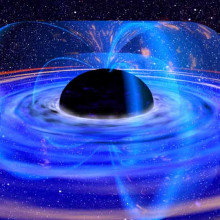
What is at the centre of the Universe?
We put this question to space scientist Judith Croston...
Judith - Okay, yes. So the questioner is right. There is a black hole in the centre of our galaxy and black holes are these very strange places in space where, essentially, no light and no matter, nothing can escape. An awful lot of matter has been squashed down - a bit like the neutron stars I was talking about before but even worse. Everything gets squashed down really, really far so there is a lot of gravity to do with a black hole.
But what's interesting really is that black holes are only weird if you get close the them. Once you're a little bit further away from the black hole, they just behave like any other star that had the same amount of mass. So actually, although in our galaxy we have stars spiralling around, we have these sort of beautiful spiral arms. But it's not the black hole at the centre that's actually controlling that, it's actually the gravity from everything else in the galaxy. So the things that the stars are orbiting around is not really the black hole, it's all the stuff in the galaxy. And there's actually much more stuff in the stars, and even more stuff in the dark matter. So it's actually ninety-five per cent of the mass in the galaxy is this strange, invisible dark matter and that's actually what controls everything moving around.
So going to the bigger picture - talking about could there be a really monster black hole and all the galaxies were spiralling around a really monstrous black hole. Well firstly, the biggest black holes we know about are about a billion suns and that's still a lot less matter than in one single galaxy. So when you think about how much gravitational pull that will have, even the biggest black holes we know about couldn't make an entire galaxy move around.
So again, when you think about what's happening and the way that galaxies are moving in the universe, which is something we can actually measure quite a lot - we can do lots of different observations - in fact again, it's the dark matter that's out there that's really controlling everything - it's not the black holes. It's pretty impossible to imagine a black hole that would be big enough to be able to control the movement of whole galaxies.

Is it really always coldest just before dawn?
We put Elizabeth's question to Chris Smith... Chris - Well, what do we think. Does everyone here agree that
the temperature appears to dip before, or around the time of dawn? Max...
Max - Yes, seems to be. I'm not sure it dips particularly but it feels like it slowly gets colder over the course of the night and then as a result it's coldest just before dawn.
Chris - So Max is disagreeing. He's saying it's colder as the Sun comes.
Do you agree Caroline?
Caroline - I think I'd agree with Max in that it seems that once the Sun sets the temperature seems to decrease consistently and then the Sun rises, would be my guess.
Chris - Judith.
Judith - I don't think there's a particular dip just before the dawn.
Chris - There is a saying "the dawn dip" and it's based on reasonable principles in physics. Because the argument goes that, as you speculate Max, where does the energy on the Earth come from and the temperature it comes from the Sun's radiation warming the Earth. When has the earth been not having any heat coming in for the longest? By definition that must be just before dawn because that's when it's been dark for longest, therefore it's going to be coolest then. But there is the observation, certainly under certain circumstances, it can get colder just ahead of the Sun coming up and as the Sun rises.
Now why should this be? Well the argument put forward is that although you are still in darkness, there's a patch of the Earth's surface quite close to you that's now being illuminated and irradiated. So temperatures there are going to start changing reasonably fast and because the Sun's heat is warmin
g the Earth's surface this is, in turn, warming the air above the Earth's surface this is, in turn, creating a pressure difference around the Earth's surface, that pressure difference is going to drive winds. And this is going to draw
colder air in to replace the warm rising air which is going to include pulling
air in from where you are, so somewhere colder could pull it's air in over you and make you even colder than you were to start with.
So the argument goes that it does get a little bit colder, paradoxically, just as the Sun rises because you get these air movements which include movements of cooler air, which will chill you out a little bit.

Is black a colour?
We put Martin's question to Caroline Steel...
Caroline - Black is just the absence of light really. It sort of seems to be a colour to us because we can differentiate it from other colours, but a black object is actually an object that absorbs all colours of the visible spectrum, that's all frequencies of light. So say this black microphone absorbs red, blue green, all of the colors, so to us it just looks like the absence of colour, which is black. So when we shut our eyes we see black as no light's getting in.
The opposite of this would be white. A white object reflects all light and when we can see all frequencies of visible light, they combine to make sort of a white colour, although colour would be a slightly misleading word.
Chris - We had Pulickel Ajayan on the programme about 2008, I think it was. And he published this paper that said the new black, and said that he'd made the blackest substance ever made. And he sent me a picture of it and I actually had this disc of this stuff and the industry standard of what we call black. And his stuff, he says, is thirty times blacker than black. It seems paradoxical that something could be blacker than black, but it really was dramatically darker.
And their technique was exactly as you say Caroline. The reason something has a colour is because it's reflecting light off it's surface. His approach was well if we want to stop light being reflected off a surface - how do we do it. They made a layer of carbon and had this bamboo like forest of carbon nanotubes sticking up like bristles off of the surface. And their rationale was any photons of light that go in there will ricochet around and just get lost in these carbon nanotubes and never come out. It just basically turns the light into heat in the surface, and that's why it's so black. But no, an amazing discovery.
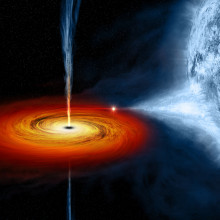
Can a planet orbit a black hole?
We put this question to Judith Croston... Judith - Yes. There are two bits to the question and so, if we think about how black holes can actually form, that sort of answers the second question about whether it would destroy the solar system.
So the best way we know about making a black hole is in what's known as a supernova explosion, which is when a really big star basically collapses and then has a really big explosion. For two reasons, if you had a solar system at that point, so if there were planets around that star, they would get blown away, they would get destroyed and that's partly because a lot of matter. there's actually less gravity and that means the planets can just go wandering off into space. But there are also shockwaves and all sorts of horrible things happening. So it's very unlikely that there would be a way for planets to survive when a black hole forms.
So if we found a planet, for example around a black hole, that would probably mean it had somehow had to get there afterwards. Either by forming around the black hole or by being captured, which is what the questioner is asking. So we haven't actually found any black holes that have planets orbiting around them, sadly.
Interestingly, there are some neutron stars that have planets around them which is kind of cool. But there are black holes that we think have captured other stars. So there are places where there are lot of stars very close together in the galaxy and we think that the chances of them banging into each other are such that it's quite likely, maybe, there's a star orbiting around a black hole that's actually been captured because they're really close together. And, actually those are some of the best ways we have of detecting the black holes in the first place is when the black holes pull stuff off the star and it falls in onto the black hole.
Caroline - So how could a star be near a black hole and not get sucked in by its immense gravity? How can a star orbit a black hole? It must surely arrive at huge speed or what happens?
Judith - Yes. So whether or not a star will get captured or fall into the black hole, as you say, it will depend on where it's coming from and how fast it's going. Now to actually get sucked into the black hole, it has to get incredibly close because, I think as I said a bit earlier, if you're far away from a black hole it just behaves like a star - the gravity just obeys the normal laws. If you want to actually get sucked into the black hole, you have to get pretty close and black holes are quite smalls, so the chances of that happening are, actually, pretty rare. It's much more likely that it will get captured in an orbit and go around it. And, in fact, we can see some stars orbiting the black hole in the centre of our galaxy and we can just watch them travelling around in these quite fast orbits and see that they are actually orbiting around the black hole, which is kind of cool.
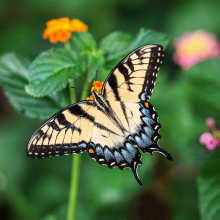
Do the different stages of a butterfly all have the same DNA?
We put this question to Max Gray...
Max - Yes, yes the do. Any single individual of any species is going to have the same DNA throughout its entire lifespan. What changes in butterflies is, particularly between a caterpillar and an adult butterfly, is they go through metamorphosis. And during this process there's a hormone which is found in most insects as they change from a larvae into an adult, which is called ecdysone, and that hormone triggers metamorphosis and it changes how DNA expression works.
So all of the cells within the caterpillar will start to produce different proteins and slowly that will cause a mass physiological change because the DNA is being expressed differently. It's creating different proteins and all of the cells will change, and what triggers that, what starts the processes of hormone being released is often an environmental factor. And a lot of caterpillars, as you might know from everybody's favourite text book "The hungry, hungry caterpillar," it'll happen when they're well fed. They'll will eat, and eat, and eat, and eat until they have enough food to be butterflies, which are basically just there to breed. The butterflies tend to live very short periods of time and most of the butterfly's lifespan is a caterpillar.
Chris - And so the bottom line is that the DNA remains constant but, under environmental and hormonal influences, you change which genes are turned on, to what extent, and where. And that's what drives the metamorphosis and also drives the behaviour?
Max - Yes, absolutely. And it's true in all manner of insects. It's not just caterpillars and butterflies.

Is the universe expanding evenly in all directions?
We put Keith's question to space scientist Judith Croston...

How much does the wind slow down when passing through a turbine?
Caroline Steel had a breeze answering this question...
Caroline - So the short answer is yes you can. When the wind turns a blade of a wind turbine it does in fact lose speed because of the sheer effort it takes to turn those blades. Now this isn't something we really need to worry about. I know there's been some speculation that this could change climate and this would have vastly terrible implications but, realistically, with the number of wind turbines we have at the moment, that decrease in wind speed is actually, completely, negligibly, unimportantly, small. Unless you're in a wind farm, in which case you don't want to put wind turbines downwind of wind turbines.
But, anyway, we can work out an efficiency for them by looking at how much energy they get out of the wind, so how much does the wind slow down versus how much energy they can output. And it actually turns out that wind turbines are relatively inefficient because there's a lot of friction between the blades and the rotor in the middle. So they have an efficiency of. it changes hugely but about forty per cent would be an okay guess. So, yes, in comparison to other energy formats wind turbines are fairly inefficient but, luckily, we've got a lot of wind so it doesn't really matter.
Chris - But a solar panel's only what twenty/twenty-five percent efficient?
Caroline - Yeah. So solar panels are fairly inefficient as well. That's something we have to live with when we're using forces to power things really.

Why do some people get motion sickness and some do not?
We put Jordan's question to Heidi Solberg Ã~kland...
Heidi - So when I'm sitting in a car, there are multiple different receptors in my body and different systems that are telling my brain about where my body is in space and what it's doing, how it's moving. So, I've got receptors in my bum saying I'm sitting still and I've got pressure from my skin saying I'm sitting still. And then, at the same time, my vestibular system inside of the inner ear where there are these canals with fluid in them that kind of slosh about and tell my brain where I am in space and help me to keep my balance. And then there's also my eyes telling me whether or not stuff is coming towards me and moving from me which will tell me about whether or not I'm moving.
In a car, you start to get mismatching signals from all these different systems. So the vestibular system is saying we're moving because the car is accelerating or decelerating and, at the same time, my eyes and the rest of my body is telling me that I'm sitting still. So this creates a sort of mismatch and the brain doesn't really know how to interpret it.
Chris - So logically the brain says ah, the right thing to do is throw up?
Caroline - Yes, so why do we get nauseous? This is something we don't actually know why. There is a theory that was posed in the 70s which was that maybe this was to do with - normally when we had this sort of mismatch going on this would be because we'd eaten some kind of a toxic food or something that meant that we need to throw it up and get rid of it - so this is the brain's best guess essentially about what's going on. And that's why maybe it's making us nauseous, although it's not been proven, it's just a theory that we have.
Chris - But, returning to Jordan's question - which is why do some people seem to succumb more than others? And, also, are older people more susceptible than younger people because I've noticed that I was immune to the worst that the fairground could throw at me when I was the age of my children but as I've got older I've become more susceptible?
Caroline - Really, okay, interesting. I've read the opposite that sometimes older people will get less susceptible to motion sickness.
Chris - Maybe they just don't go on the fairground so much - that's what it is.
Caroline - So, individual differences can come from maybe that people have different levels of sensitivity in their vestibular system, so some people will be maybe relying more on their vestibular system than others to keep their balance or to know where their body is in space. So if you're very sensitive then maybe you're also more prone to motion sickness. Also your brain needs to know that you're okay, so if you train yourself to tell your body that this is fine and we're not in any danger and we're not being poisoned then, over time, you get used to it and then that stops this nausea from happening.
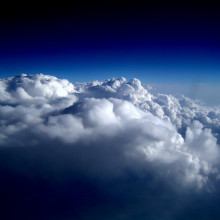
Why don't clouds fall to the ground?
We put Isabella's question to Chris Smith... Chris - Now the reason that clouds stay up where they are is because there are strong winds pushing the clouds upwards. What do I mean by that?
Well, clouds are full of water and, in fact, if we weighed a cloud that was one kilometer by one kilometer by one kilometer, because scientists have measured how much water there is in a cloud it would weigh about five hundred tons. But the water isn't in one giant blob, it's in lots of tiny particles and ice crystals which are called hydrometeors, and these have a very big surface area compared to their size. And because the Earth is constantly being heated up by the Sun shining on the Earth's surface, warming the surface, the surface warms the air above the surface, and the warm air rises because it expands and become less dense. So there's a column of warm rising air which is pushing upwards and this hits these tiny water particles which are trying to fall down under their own weight and it keeps them up there.
And that's why clouds have a flat bottom, because that's the point at which the tiny water crystals particles inside, which are trying to fall downwards, meet the warm air coming upwards and the two balance each other out, and the form the cloud base. So that's why clouds stay up there and also why five hundred tons of water in one cloud doesn't come crashing straight down to the Earth. Good thing really, isn't it!









Comments
Add a comment